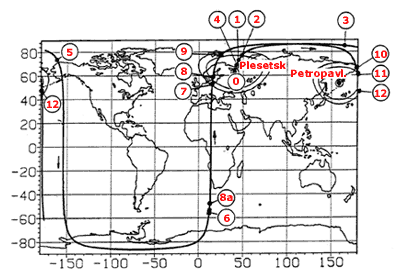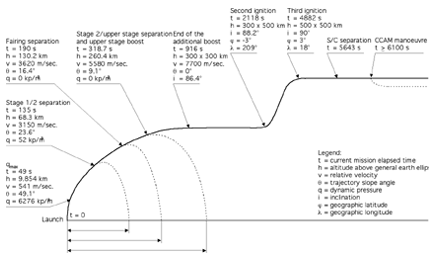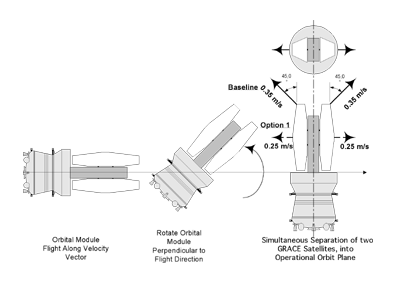
|
Rockot Launch Vehicle : GRACE Program
Missions | History / Production | Technical Description | Rockot and the GRACE program | Rockot Images | 

 Figure : Grace Spacecraft Separation Scenario (45 as baseline and lateral as option) (The sketch shows Grace sats in the old configuration) After third Breeze burn for circularization at 500km a certain time passes until Breeze enters the visibility zone at t = 5543s. After a minimum duration of 100s within the visibility zone and subsequent to the orientation of the Breeze main axis perpendicular to the along-track velocity and parallel to the orbital plane, separation of the two Grace spacecraft takes place. After the spacecraft have reached a distance of at least of 30-40m, the orientation of Breeze can be changed with the 13N AOCS engines. After achieving at least 200m distance, Breeze will be removed from the Grace orbit by activation of the 400N vernier thrusters which will burn until the rest of the fuel is exhausted; the propellant and pressurant tanks will subsequently be vented to put Breeze in safe condition. Experience with similar altitude missions indicates that a natural orbital decay or a controlled re-entry may be possible, depending on the precise delta V imparted and solar cycle conditions. However this is subject to precise mission analysis at a later date. All separation take place within the visibility zones provided by Plesetsk, Moscow and St. Petersburg ground station. Orbit removal manouver will take place outside visibility, data on successful performance will be transferred to ground via store and forward capability of telemetry system. Using this scenario, Rockot provides a safe separation within the same visibility zone and using thruster activation distances avoiding any spacecraft contamination. As an option, spacecraft separation outside and Breeze orbit removal within visibility is also possible using the programmable flight control and telemetry store and forward capabilities of the Breeze upper stage. Information and graphics courtesy of T. Miski (Eurockot). |

